Evolution Characteristics and Driving Mechanisms of Innovation’s Spatial Pattern in Beijing–Tianjin–Hebei Urban Agglomeration Under Coordinated Development Policy: Evidence from Patent Data
Abstract
1. Introduction
2. Literature Review
2.1. Research on Theoretical Foundations
2.2. Research on Evolution of Research Perspectives
2.3. Research on the Influencing Factors
2.4. Limitations of the Existing Research
3. Research Area and Methodology
3.1. Study Area
3.2. Data Sources
3.3. Methodology
3.3.1. Spatial Gini Coefficient
3.3.2. Spatial Variation Coefficient
3.3.3. Standard Deviation Ellipse and Spatial Centroid
3.3.4. Location Quotient
3.3.5. Exploratory Regression and Geographically Weighted Regression
3.3.6. Policy Strength Index (PSI)
3.4. Technical Roadmap
4. Results
4.1. Spatiotemporal Evolution of Innovation Patterns
4.1.1. Dynamic Agglomeration Characteristics
4.1.2. Gradient Evolution of Innovation Spatial Disparities
4.2. Exploration of the Driving Mechanisms and Influencing Factors of Innovation Space in High-Tech Industries
4.2.1. Characteristics of Innovation Spatial Patterns by High-Tech Industry Sub-Sector
4.2.2. Analysis of Specialization in High-Tech Industry Innovation
4.2.3. Factors Influencing Innovation in High-Tech Industries
4.3. Research on the Coordination Mechanism of Innovation Space Policy
4.3.1. Analysis of Policy Intensity Findings
4.3.2. Comparative Insights from Global Urban Agglomerations
5. Discussion
5.1. Key Findings on the BTH Innovation Landscape
5.2. Comparative Analysis with Planning Frameworks
5.3. Policy Implications and Recommendations
5.4. Practical Applications of the Study
6. Conclusions
Author Contributions
Funding
Data Availability Statement
Conflicts of Interest
Appendix A

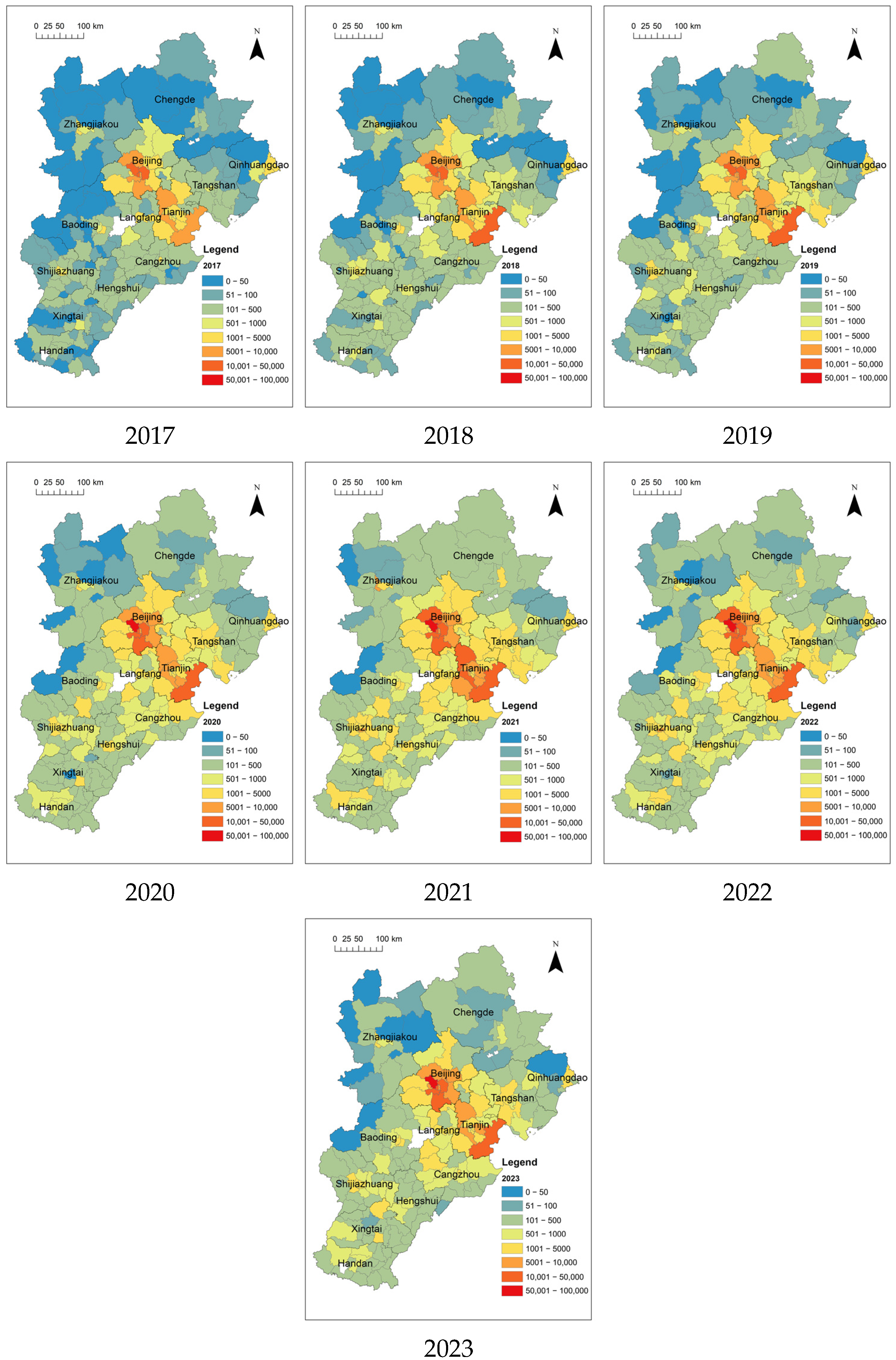
References
- Zhang, J.X.; He, H.M. Beyond Growth: Innovation of Spatial Planning to Address Innovative Economy. City Plan. Rev. 2019, 43, 18–25. (In Chinese) [Google Scholar]
- Scott, A.J.; Storper, M. The Nature of Cities: The Scope and Limits of Urban Theory. Int. J. Urban Reg. Res. 2015, 39, 1–15. [Google Scholar] [CrossRef]
- Tang, S.; Zhang, J.X. Review on Progress and Prospect of Urban Innovation Space and Its Planning Practice. Urban Res. 2022, 3, 87–93. (In Chinese) [Google Scholar] [CrossRef]
- Florida, R.; Adler, P.; Mellander, C. The City as Innovation Machine. Reg. Stud. 2017, 51, 86–96. [Google Scholar] [CrossRef]
- Yang, N.; Liu, Q.; Chen, Y. Does Industrial Agglomeration Promote Regional Innovation Convergence in China? Evidence From High-Tech Industries. IEEE Trans. Eng. Manag. 2023, 70, 1416–1429. [Google Scholar] [CrossRef]
- Wang, W.; Liu, Y.; Hu, Q. How Does Urban Agglomeration Knowledge Network Structure Affect Innovation Productivity: The Moderating Role of Urban Digitalisation. Technol. Anal. Strateg. Manag. 2025, 37, 1–17. [Google Scholar] [CrossRef]
- Xiao, Z.; Li, H.; Gao, Y. Analysis of the Impact of the Beijing-Tianjin-Hebei Coordinated Development on Environmental Pollution and Its Mechanism. Environ. Monit. Assess. 2022, 194, 91. [Google Scholar] [CrossRef]
- Ma, B.; Li, Y.; Zhou, B.; Jian, Y.; Zhang, C.; An, J. The Green Development Mechanism of the Beijing-Tianjin-Hebei Coordinated Development Strategy in China: Novel Evidence of Green Finance. Int. Rev. Econ. Financ. 2025, 98, 103941. [Google Scholar] [CrossRef]
- Ge, L.; Li, C.; Sun, L.; Hu, W.; Ban, Q. The Relationship between High-Tech Industrial Agglomeration and Regional Innovation: A Meta-Analysis Investigation in China. Sustainability 2023, 15, 6545. [Google Scholar] [CrossRef]
- Tian, Y.; Kan, C.; Li, X.; Dang, A. An Analysis of Agglomeration Structure for Beijing, Tianjin, and Hebei Based on Spatial-Temporal Big Data. Comput. Urban Sci. 2024, 4, 11. [Google Scholar] [CrossRef]
- Sun, Y.; Zhao, S. Spatiotemporal Dynamics of Urban Expansion in 13 Cities across the Jing-Jin-Ji Urban Agglomeration from 1978 to 2015. Ecol. Indic. 2018, 87, 302–313. [Google Scholar] [CrossRef]
- Huang, D.; Wu, J.; Chen, W. Coordinated Development Strategy of the Beijing-Tianjin-Hebei Region. In Dictionary of Contemporary Chinese Economics; Hong, Y.X., Ed.; Springer Nature Singapore: Singapore, 2025; pp. 2041–2043. ISBN 978-981-97-4036-9. [Google Scholar]
- Chen, X.; Wang, H. Spatial–Temporal Evolution and Driving Factors of Industrial Land Marketization in Chengdu–Chongqing Economic Circle. Land 2024, 13, 972. [Google Scholar] [CrossRef]
- Cao, Y.; Kong, L.; Xu, Z.; Ding, Z.; Wang, L.; Liu, Y.; Li, R.; Shu, C.; Ouyang, Z. Exploring Coordinated Pathways for Sustainable Ecosystem and Socioeconomic Development: A Case Study of the Beijing-Tianjin-Hebei Region. Sustain. Futures 2025, 9, 100691. [Google Scholar] [CrossRef]
- Chen, Y.; Zhang, S.; Yang, L.; Zhang, X.; Yu, K.; Li, J. Ecological Footprint in Beijing-Tianjin-Hebei Urban Agglomeration: Evolution Characteristics, Driving Mechanism, and Compensation Standard. Environ. Impact Assess. Rev. 2024, 109, 107649. [Google Scholar] [CrossRef]
- Yue, Q. A Study on the Cooperative Innovation of Beijing-Tianjin-Hebei Based on System Model. In Proceedings of the 2020 International Conference on Urban Engineering and Management Science (ICUEMS), Zhuhai, China, 24–26 April 2020; pp. 83–86. [Google Scholar]
- Tian, J.; Ma, J.; Zeng, S.; Bai, Y. Characteristics and Driving Factors of the Spatial and Temporal Evolution of County Urban–Rural Integration—Evidence from the Beijing–Tianjin–Hebei Region, China. Land 2025, 14, 1563. [Google Scholar] [CrossRef]
- Chen, Q.; Liu, Y.; Yao, Z. Spatial–Temporal Pattern Evolution and Differentiation Mechanism of Urban Dual Innovation: A Case Study of China’s Three Major Urban Agglomerations. Land 2024, 13, 1399. [Google Scholar] [CrossRef]
- Kemeny, T.; Petralia, S.; Storper, M. Disruptive Innovation and Spatial Inequality. Reg. Stud. 2025, 59, 2076824. [Google Scholar] [CrossRef]
- Huang, D.; Xu, G.; Li, C.; Yang, S. Effects of High-Tech Industrial Agglomeration and Innovation on Regional Economic Development in China: Evidence from Spatial-Temporal Analysis and Spatial Durbin Model. Econ. Anal. Policy 2025, 86, 692–712. [Google Scholar] [CrossRef]
- Fan, D.C.; Li, S.N. Research on R&D Innovation Efficiency of Regional High-Tech Industry Considering Spatial Effect. In Proceedings of the 2017 International Conference on Management Science and Engineering (ICMSE), Nomi, Japan, 17–20 August 2017; pp. 313–320. [Google Scholar]
- Schumpeter, J.A. The Theory of Economic Development: An Inquiry into Profits, Capital, Credit, Interest, and the Business Cycle; Transaction Publishers: Piscataway, NJ, USA, 1934. [Google Scholar]
- Marshall, A. Principles of Economics; Palgrave Classics in Economics; Palgrave Macmillan London: London, UK, 1890; ISBN 978-1-137-37526-1. [Google Scholar]
- Jacobs, J. The Economy of Cities; The Economy of Cities; Vintage: New York, NY, USA, 1969. [Google Scholar]
- Portergoff, M.; Portergoff, M.; Porter, M.E.; Porter, M.; Porter, M.A.; Portergoff, M.E.; Porter, M.E.; Porter, M.E.; Porter, S.; Porter, M.E. The Competitive Advantage of Nations; The Competitive Advantage of Nations; Free Press: New York, NY, USA, 1990. [Google Scholar]
- Caragliu, A.; Del Bo, C.; Nijkamp, P. Smart Cities in Europe. In Creating Smart-er Cities; Routledge: London, UK, 2009. [Google Scholar]
- Florida, R. The Rise of the Creative Class. Wash. Mon. 2002, 35, 593–596. [Google Scholar]
- Taş, M.A.; Alptekin, S.E. Evaluation of Major Cities in Terms of Smart Cities: A Developing Country Perspective. Procedia Comput. Sci. 2023, 225, 1717–1726. [Google Scholar] [CrossRef]
- Yakubovich, V.; Wu, S. OrgTech: Evidence of Organizational Innovations in Patent Data. Res. Policy 2025, 54, 105209. [Google Scholar] [CrossRef]
- Cooke, P. Regional Innovation Systems: Competitive Regulation in the New Europe. Geoforum 1992, 23, 365–382. [Google Scholar] [CrossRef]
- Crepon, B.; Duguet, E.; Mairessec, J. Research, Innovation and Productivi[Ty: An Econometric Analysis at the Firm Level. Econ. Innov. New Technol. 1998, 7, 115–158. [Google Scholar] [CrossRef]
- Audretsch, D.B.; Lehmann, E.E.; Warning, S. University Spillovers and New Firm Location. Res. Policy 2005, 34, 1113–1122. [Google Scholar] [CrossRef]
- Strange, W.; Hejazi, W.; Tang, J. The Uncertain City: Competitive Instability, Skills, Innovation and the Strategy of Agglomeration. J. Urban Econ. 2006, 59, 331–351. [Google Scholar] [CrossRef]
- Berliant, M.; Reed, R.R.; Wang, P. Knowledge Exchange, Matching, and Agglomeration. J. Urban Econ. 2006, 60, 69–95. [Google Scholar] [CrossRef]
- Peirone, D.; Pereira, D.B.; Leitão, J.; Nezghoda, O. The Role of the Agglomeration Economy and Innovation Ecosystem in the Process of Competency Development and Growth of Small and Medium-Sized Enterprises. Adm. Sci. 2024, 14, 222. [Google Scholar] [CrossRef]
- Sun, Y.K.; Li, G.P.; Yuan, W.W.; Sun, T.S. The Spatial Concentration of Innovation and its Mechanisms: A Literature Review and Prospect. Hum. Geogr. 2017, 32, 17–24. [Google Scholar] [CrossRef]
- Gao, Y.; Cheng, L.; Ren, Y.; Hu, Y.; Chen, L.; Tian, J. High-Quality Development in Industrial Parks: New Narrative and Pathway to Sustainable Development from a Policy Perspective in China. Resour. Conserv. Recycl. 2025, 215, 108111. [Google Scholar] [CrossRef]
- Luo, Y.; Shen, J. Urban Entrepreneurialism, Metagovernance and ‘Space of Innovation’: Evidence from Buildings for Innovative Industries in Shenzhen, China. Cities 2022, 131, 104067. [Google Scholar] [CrossRef]
- Gao, Y.; Lin, R.; Lu, Y. A Visualized Analysis of the Research Current Hotspots and Trends on Innovation Chain Based on the Knowledge Map. Sustainability 2022, 14, 1708. [Google Scholar] [CrossRef]
- Li, G.; Yuan, Q.; Liu, X.; Zhan, W.; Yang, S. Measuring Intra-Urban Innovation Space from the Unit-Network Perspective: A Case Study of Guangzhou. Land 2025, 14, 504. [Google Scholar] [CrossRef]
- Yigitcanlar, T. (Ed.) Rethinking Sustainable Development: Urban Management, Engineering, and Design; Advances in Environmental Engineering and Green Technologies; IGI Global: New York, NY, USA, 2010; ISBN 978-1-61692-022-7. [Google Scholar]
- Li, Y.; Wei, Y.; Li, Y.; Lei, Z.; Ceriani, A. Connecting Emerging Industry and Regional Innovation System: Linkages, Effect and Paradigm in China. Technovation 2022, 111, 102388. [Google Scholar] [CrossRef]
- Mi, R.; Liu, S.; Liu, C.; Li, Z.; Li, S. The Nexus of Digitalization, Talent, and High-Quality Development: How Clusters Foster Sustainable Economic Growth. Sustainability 2025, 17, 503. [Google Scholar] [CrossRef]
- Qi, L.; Zhang, Y.; Chen, Y.; Chen, L.; Zhou, S.; Wei, X. The Spatial Pattern Evolution of Urban Innovation Actors and the Planning Response to Path Dependency: A Case Study of Guangzhou City, China. Urban Sci. 2024, 8, 111. [Google Scholar] [CrossRef]
- Alcácer, J.; Chauvin, J. The Extent and Drivers of Internal Agglomeration of U.S. Multi-Unit Firms. Strateg. Manag. J. 2025, 46, 1–39. [Google Scholar] [CrossRef]
- Lehmann, E.E.; Schenkenhofer, J.; Vismara, S. Hidden Champions and Knowledge Spillovers: Innovation-Enhancing Agglomeration Effects and Niche Technology Specificity. Small Bus. Econ. 2025, 65, 1–21. [Google Scholar] [CrossRef]
- Grieser, W.; Maturana, G.; Spyridopoulos, I.; Truffa, S. Agglomeration, Knowledge Spillovers, and Corporate Investment. J. Corp. Financ. 2022, 77, 102289. [Google Scholar] [CrossRef]
- Li, L.; Wang, L.; Zhang, X.; Wang, L. Technological Composition and Innovation Factors in Inventive Yangtze River Delta: Evidence from Patent Inventions. Appl. Sci. 2024, 14, 1842. [Google Scholar] [CrossRef]
- Chen, J.; Jiang, L.; Tian, Y.; Luo, J. The Study of Regional Innovation Network Structure: Evidence from the Yangtze River Delta Urban Agglomeration. ISPRS Int. J. Geo-Inf. 2023, 12, 428. [Google Scholar] [CrossRef]
- Hu, E.; Hu, D.; He, H. Spatial Patterns of Urban Innovation and Their Evolution from Perspectives of Capacity and Structure: Taking Shenzhen as an Example. ISPRS Int. J. Geo-Inf. 2021, 11, 7. [Google Scholar] [CrossRef]
- Liu, B.; Xue, D.; Zheng, S. Evolution and Influencing Factors of Manufacturing Production Space in the Pearl River Delta—Based on the Perspective of Global City-Region. Land 2023, 12, 419. [Google Scholar] [CrossRef]
- Li, Z.; Liu, Y. Research on the Spatial Distribution Pattern and Influencing Factors of Digital Economy Development in China. IEEE Access 2021, 9, 63094–63106. [Google Scholar] [CrossRef]
- Liang, L.; Chen, M.; Luo, X.; Xian, Y. Changes Pattern in the Population and Economic Gravity Centers since the Reform and Opening up in China: The Widening Gaps between the South and North. J. Clean. Prod. 2021, 310, 127379. [Google Scholar] [CrossRef]
- Yu, H. Generalized Geographically and Temporally Weighted Regression. Comput. Environ. Urban Syst. 2025, 117, 102244. [Google Scholar] [CrossRef]
- Zhang, L.; Zhang, R.; Wang, Z.; Yang, F. Spatial Heterogeneity of the Impact Factors on Gray Water Footprint Intensity in China. Sustainability 2020, 12, 865. [Google Scholar] [CrossRef]
- Sheng, S.; Huang, J. Spatiotemporal Dynamics and Driving Mechanisms of Ecosystem Services in the Beijing–Tianjin–Hebei Urban Agglomeration: Implications for Sustainable Land Use Planning. Land 2025, 14, 969. [Google Scholar] [CrossRef]
- Zhang, W.; Qian, Y.; Tang, J.; Liu, X. Exploring Cooperative and Competitive Relations in a Chinese Intercity Innovation Network. Appl. Geogr. 2025, 175, 103508. [Google Scholar] [CrossRef]
- Liu, D.; Zhang, K. Analysis of Spatial Differences and the Influencing Factors in Eco-Efficiency of Urban Agglomerations in China. Sustainability 2022, 14, 2611. [Google Scholar] [CrossRef]
- Yuan, X.; Ren, J.; Gu, C.; Shi, X.; Liu, X.; Chen, J.; Wang, L. Innovation Districts in Beijing: Evolution, Distribution, and Development Mechanisms. In Chinese Urban Planning and Construction: From Historical Wisdom to Modern Miracles; Bian, L., Tang, Y., Shen, Z., Eds.; Springer International Publishing: Cham, Switzerland, 2021; pp. 275–299. ISBN 978-3-030-65562-4. [Google Scholar]
- Zhang, G.; Liu, J.Q.; Li, J.Y. Leading the Construction of Beijing-Tianjin-Hebei World-Class Urban Agglomeration with Beijing-Tianjin-Xiong’an Innovation Triangle Area. Const. Communist Party China 2019, 21, 64–70. [Google Scholar] [CrossRef]
- Wang, N.; Guo, J.; Zhang, X.; Zhang, J.; Li, Z.; Meng, F.; Zhang, B.; Ren, X. The Circular Economy Transformation in Industrial Parks: Theoretical Reframing of the Resource and Environment Matrix. Resour. Conserv. Recycl. 2021, 167, 105251. [Google Scholar] [CrossRef]
- Dai, C.; Li, Y.; Lu, S. Research on Regional Economic Development Level Based on Spatial Econometric Model. In Proceedings of the 2024 7th International Conference on E-Business, Information Management and Computer Science, Hong Kong, China, 20–22 December 2024; Association for Computing Machinery: New York, NY, USA, 2025; pp. 47–52. [Google Scholar]
- Yang, A.; Tan, M. Research on Urbanization of Middle and South Hebei from the Perspective of High Mobility. Appl. Comput. Eng. 2024, 78, 181–186. [Google Scholar] [CrossRef]
- Zhuang, T.; Zhao, S.; Zheng, M.; Chu, J. Triple Helix Relationship Research on China’s Regional University–Industry–Government Collaborative Innovation: Based on Provincial Patent Data. Growth Change 2021, 52, 1361–1386. [Google Scholar] [CrossRef]
- Wu, Y.Q.; Leng, X.R. A Review and Outlook on the 10th Anniversary of the Coordinated Development of the Beijing-Tianjin-Hebei Region. Econ. Manag. 2024, 38, 1–8. [Google Scholar]
- Chen, J.; Yin, X.; Mei, L. Holistic Innovation: An Emerging Innovation Paradigm. Int. J. Innov. Stud. 2018, 2, 1–13. [Google Scholar] [CrossRef]
- Xu, A.; Qiu, K.; Jin, C.; Cheng, C.; Zhu, Y. Regional Innovation Ability and Its Inequality: Measurements and Dynamic Decomposition. Technol. Forecast. Soc. Change 2022, 180, 121713. [Google Scholar] [CrossRef]
- Tang, H.H. The Strategic Role of World-Class Universities in Regional Innovation System: China’s Greater Bay Area and Hong Kong’s Academic Profession. Asian Educ. Dev. Stud. 2020, 11, 7–22. [Google Scholar] [CrossRef]
- McNeill, D. Governing a City of Unicorns: Technology Capital and the Urban Politics of San Francisco. Urban Geogr. 2016, 37, 494–513. [Google Scholar] [CrossRef]
- Matsubara, H. Industrial Structural Changes in the Tokyo Metropolitan Area. J. Geogr. (Chigaku Zasshi) 2014, 123, 285–297. [Google Scholar] [CrossRef]
- Leijten, J. Innovation Policy and International Relations: Directions for EU Diplomacy. Eur. J. Futures Res. 2019, 7, 4. [Google Scholar] [CrossRef]
- Marullo, C.; Shapira, P.; Minin, A.D. Enhancing SME Innovation across European Regions: Success Factors in EU-Funded Open Innovation Networks. Technol. Forecast. Soc. Change 2024, 201, 123207. [Google Scholar] [CrossRef]
- Pan, W.; Wang, J.; Lu, Z.; Liu, Y.; Li, Y. High-Quality Development in China: Measurement System, Spatial Pattern, and Improvement Paths. Habitat. Int. 2021, 118, 102458. [Google Scholar] [CrossRef]
- Zhang, H.; Li, F.; Wei, S.; Jiang, L.; Xiong, J.; Zhang, T. Spatiotemporal Evolution Characteristics and Influencing Factors of Digital Industry in China. Sci. Rep. 2024, 14, 28591. [Google Scholar] [CrossRef] [PubMed]
- Chen, J.; Yin, X.; Fu, X.; McKern, B. Beyond Catch-up: Could China Become the Global Innovation Powerhouse? China’s Innovation Progress and Challenges from a Holistic Innovation Perspective. Ind. Corp. Change 2020, 30, 1037–1064. [Google Scholar] [CrossRef]


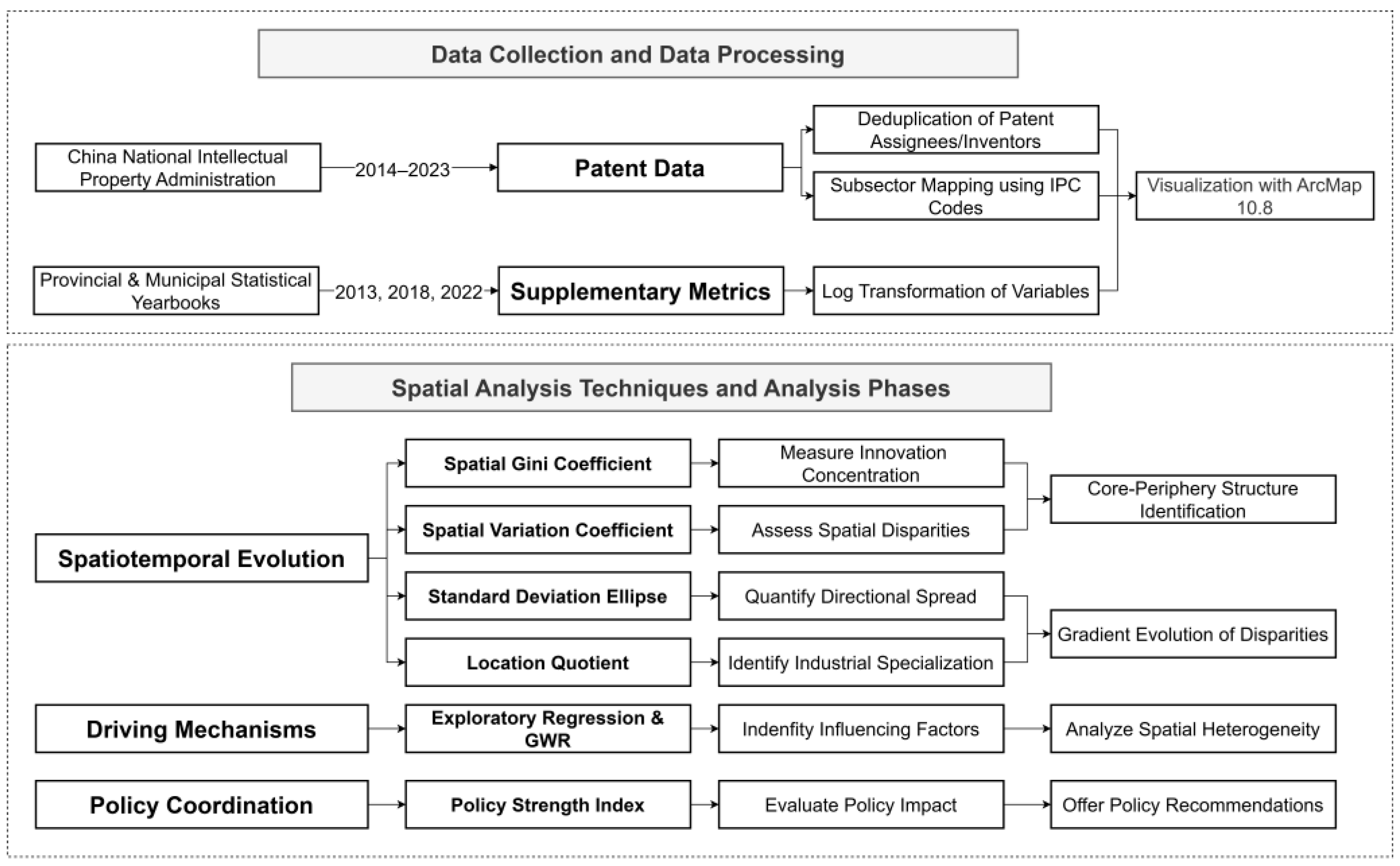
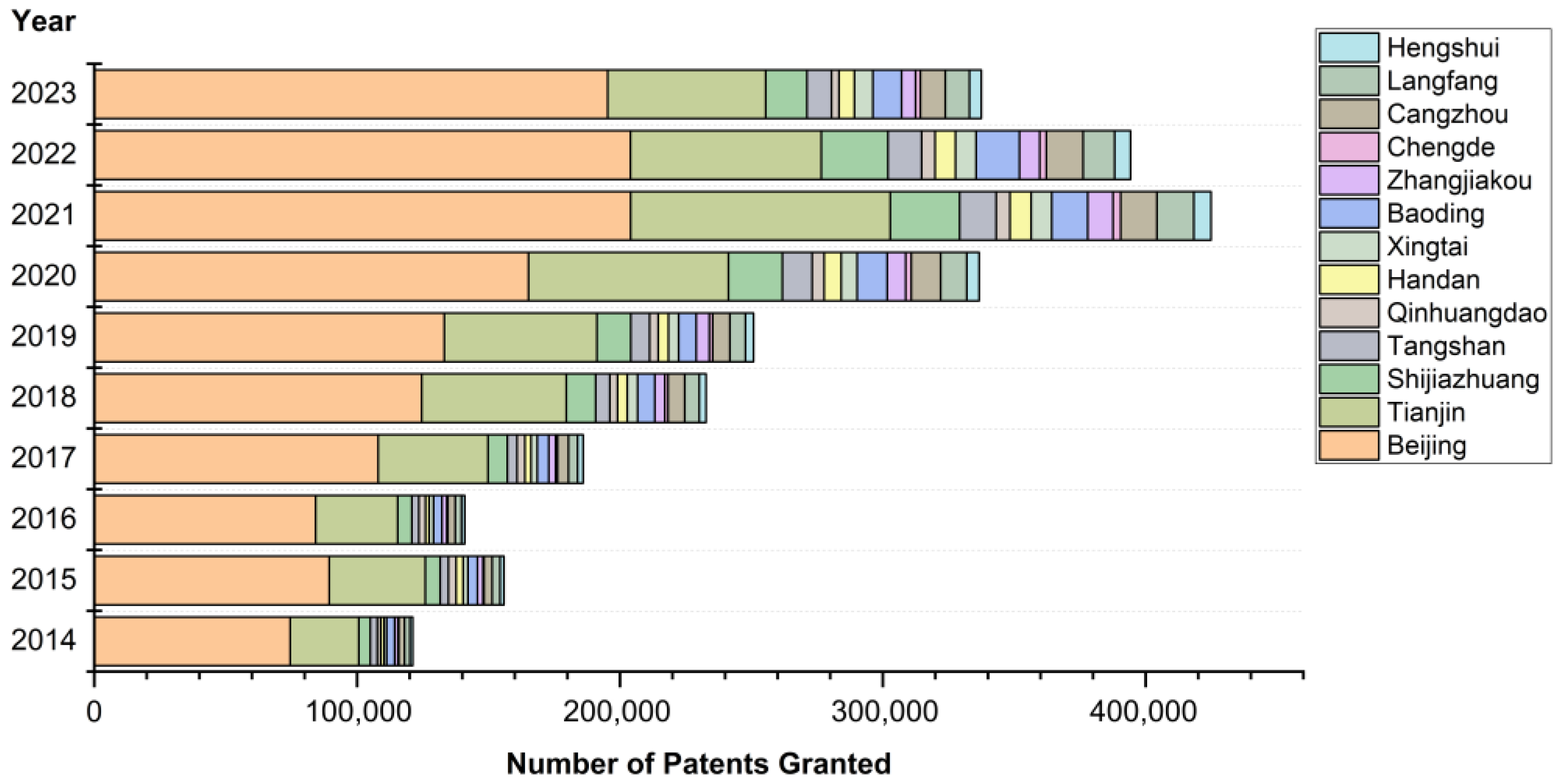



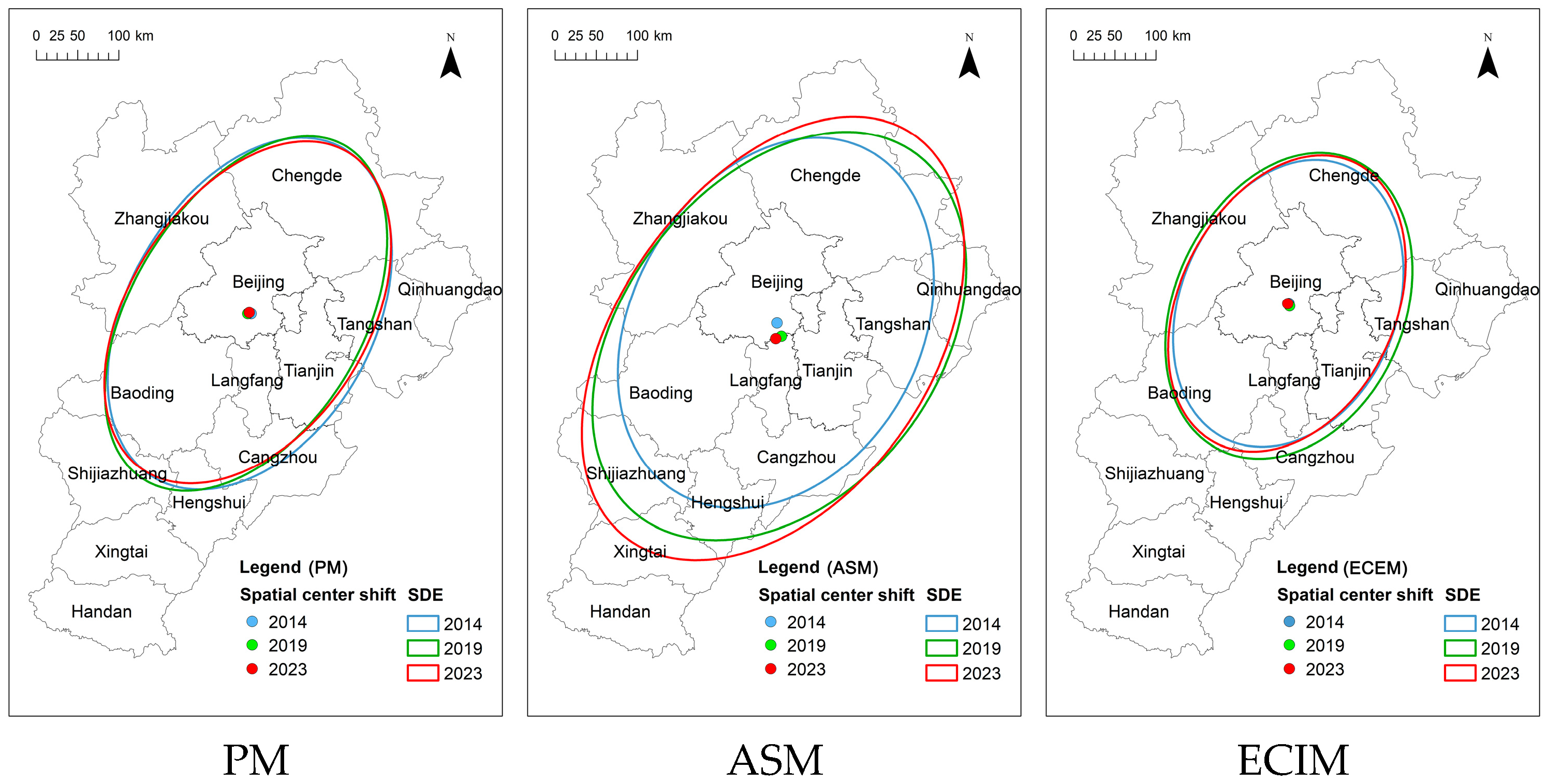

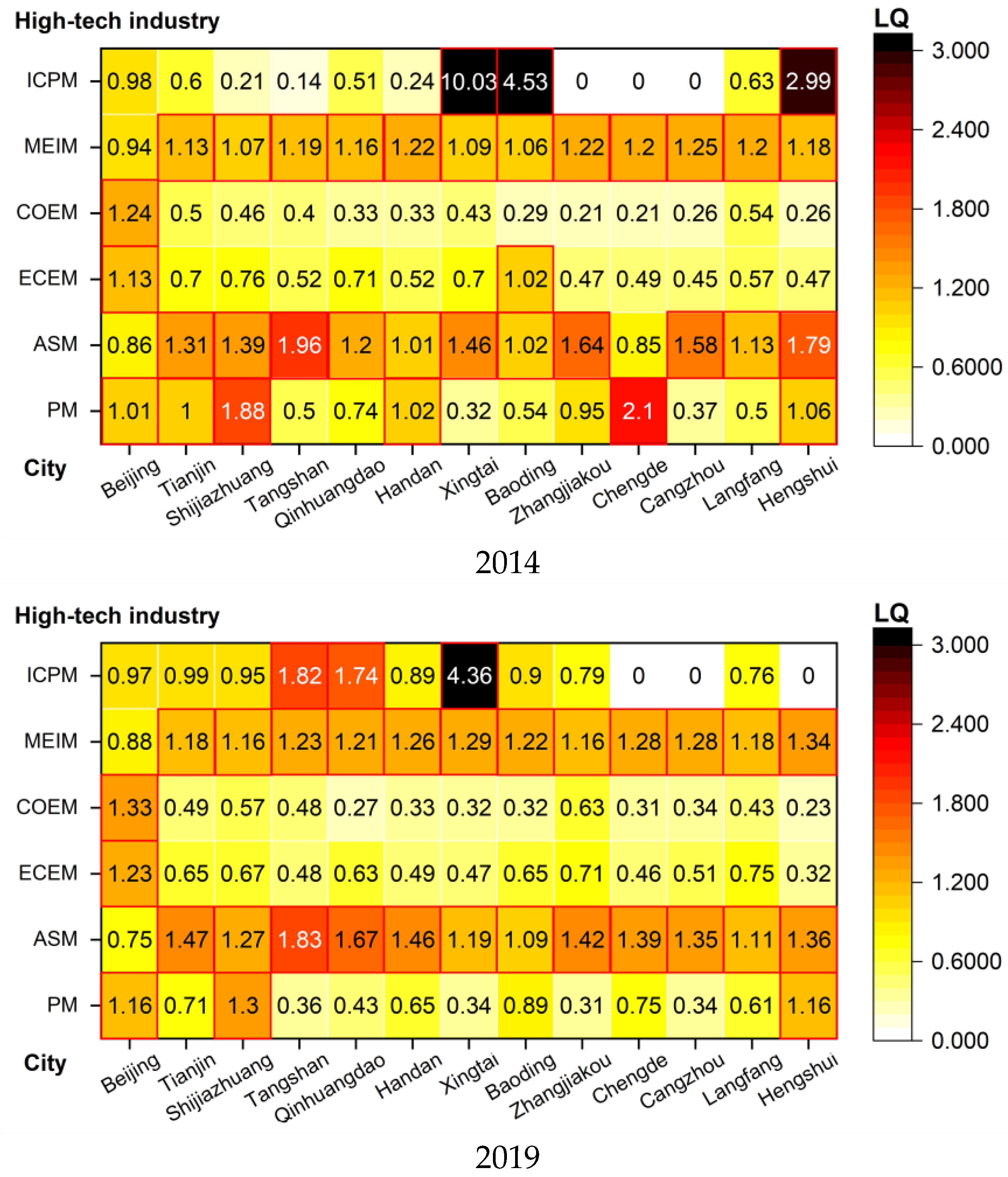


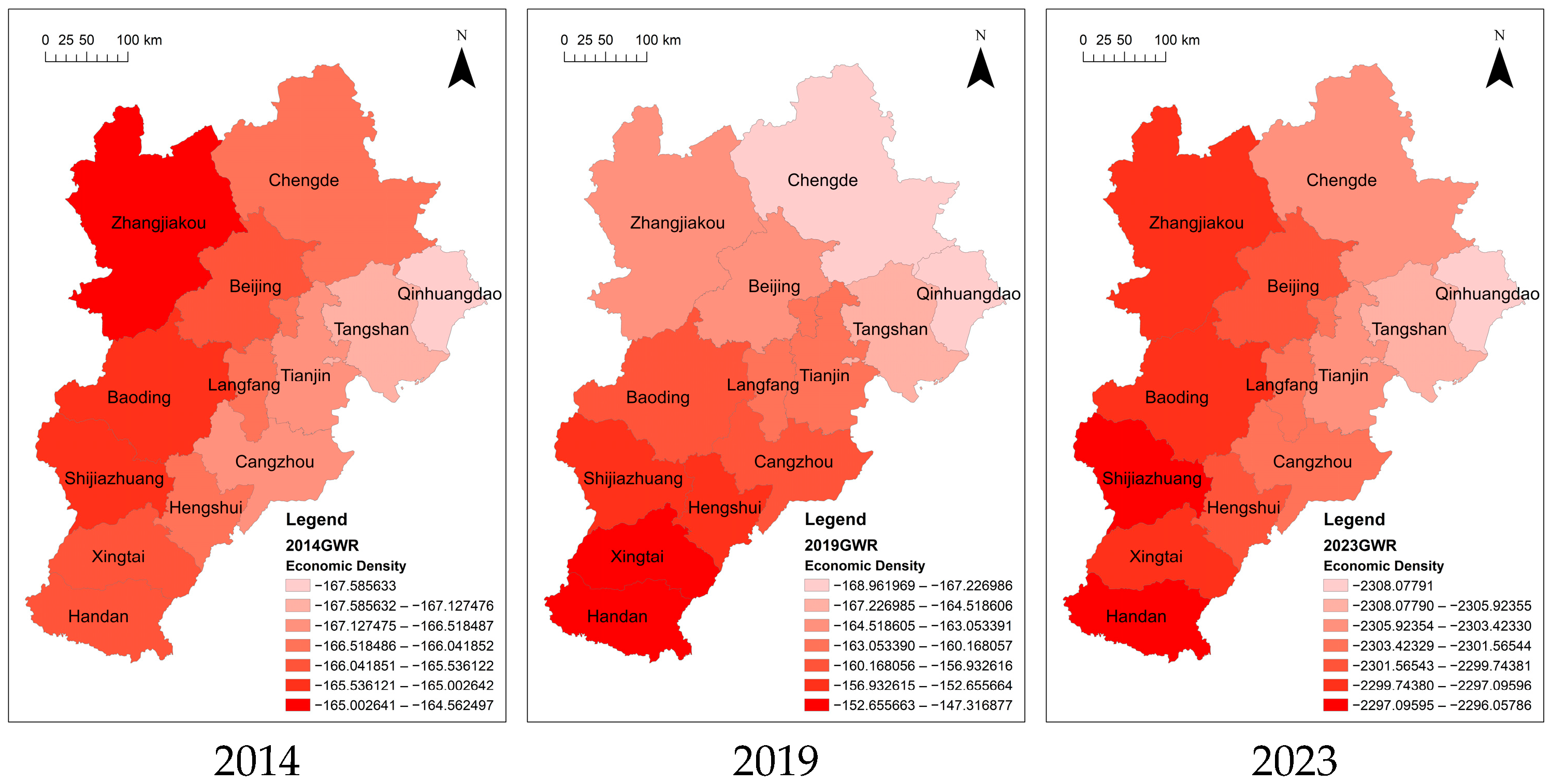



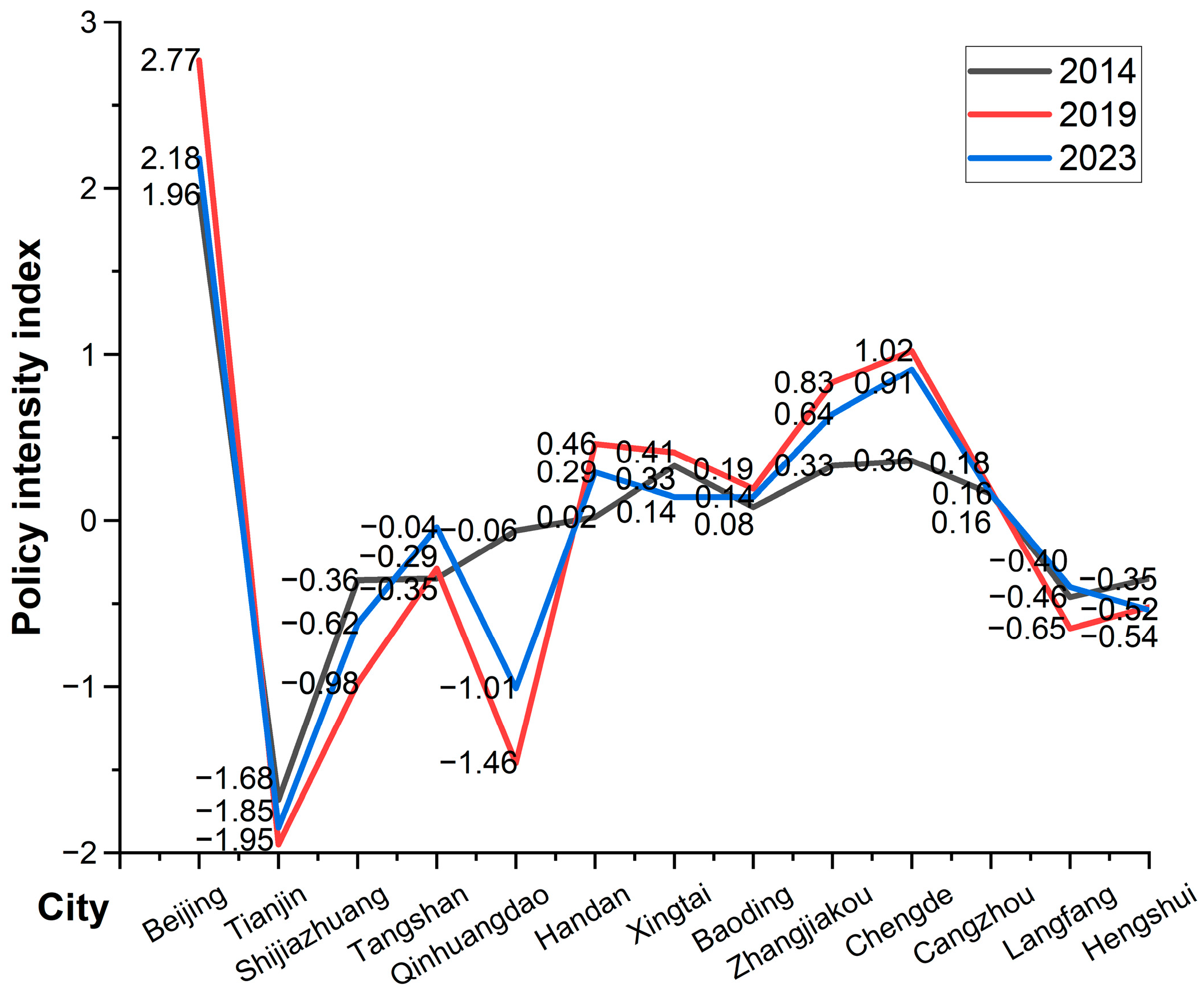
| Data Type | Source | Corresponding Years | Description |
|---|---|---|---|
| Patent grants | China National Intellectual Property Administration (CNIPA) | 2014–2023 | Including Invention, Utility Model and Design patent |
| Supplementary Metrics | Provincial and Municipal Statistical Yearbooks and Bulletins | 2013, 2018, 2022 | Including economic conditions, R&D capacity, openness level, living conditions, ecological quality, and transportation infrastructure |
| Spatial Units | Geospatial Data Cloud | As of year-end 2023 administrative divisions | Boundaries for 13 prefecture-level cities and 194 counties in the BTH urban agglomeration |
| Category | Code | Factor | Description |
|---|---|---|---|
| Economic Environment | X1 | Economic density | GDP/area |
| X2 | Economic development | Per capita GDP | |
| R&D environment | X3 | R&D expenditure | R&D funding |
| X4 | Fiscal S&T expenditure | Government S&T spending | |
| Openness level | X5 | Export intensity | Exports/GDP |
| X6 | FDI utilization | Actual FDI | |
| Living conditions | X7 | Disposable income | Urban per capita income |
| X8 | Urbanization rate | Urban population share | |
| Ecological quality | X9 | Green space | Green area |
| Transportation infrastructure | X10 | Road density | Highway mileage |
| Subsectors | Year | Major Axis (km) | Minor Axis (km) | Rotation | Centroid Coordinates |
|---|---|---|---|---|---|
| PM | 2014 | 231.24 | 149.79 | 31.16 | (116.47, 39.83) |
| 2019 | 237.37 | 141.08 | 32.38 | (116.42, 39.83) | |
| 2023 | 230.29 | 144.52 | 34.62 | (116.44, 39.85) | |
| ASM | 2014 | 238.89 | 175.75 | 30.70 | (116.57, 39.73) |
| 2019 | 278.56 | 189.73 | 39.25 | (116.64, 39.59) | |
| 2023 | 302.12 | 189.15 | 36.14 | (116.56, 39.56) | |
| ECEM | 2014 | 181.20 | 131.70 | 25.23 | (116.48, 39.95) |
| 2019 | 194.22 | 140.02 | 26.41 | (116.49, 39.92) | |
| 2023 | 190.31 | 131.33 | 28.10 | (116.46, 39.95) | |
| COEM | 2014 | 141.67 | 107.43 | 13.12 | (116.48, 40.04) |
| 2019 | 169.96 | 122.78 | 23.91 | (116.47, 39.99) | |
| 2023 | 161.26 | 120.69 | 23.94 | (116.47, 40.00) | |
| MEIM | 2014 | 226.93 | 163.31 | 26.64 | (116.54, 39.80) |
| 2019 | 269.21 | 179.53 | 34.19 | (116.55, 39.66) | |
| 2023 | 291.45 | 174.66 | 33.04 | (116.46, 39.65) | |
| ICPM | 2014 | 289.11 | 122.82 | 26.70 | (116.28, 39.71) |
| 2019 | 282.60 | 175.39 | 36.22 | (116.54, 39.70) | |
| 2023 | 225.64 | 150.79 | 28.31 | (116.50, 39.82) |
| Variable | 2014 | 2019 | 2023 | ||||||
|---|---|---|---|---|---|---|---|---|---|
| Sig. | Pos. | Neg. | Sig. | Pos. | Neg. | Sig. | Pos. | Neg. | |
| X1 | 30.47 | 28.12 | 71.88 | 52.76 | 92.91 | 7.09 | 11.76 | 65.49 | 34.51 |
| X2 | 1.95 | 23.44 | 76.56 | 11.07 | 39.53 | 60.47 | 8.33 | 22.62 | 77.38 |
| X3 | 98.05 | 100.00 | 0.00 | 66.94 | 97.93 | 2.07 | 67.06 | 87.70 | 12.30 |
| X4 | 68.36 | 82.81 | 17.19 | 76.03 | 100.00 | 0.00 | 83.33 | 97.56 | 2.44 |
| X5 | 21.48 | 57.81 | 42.19 | 10.24 | 92.52 | 7.48 | 4.71 | 63.53 | 36.47 |
| X6 | 68.36 | 2.34 | 97.66 | 42.15 | 53.31 | 46.69 | 56.45 | 95.56 | 4.44 |
| X7 | 21.09 | 80.86 | 19.14 | 13.04 | 37.94 | 62.06 | 16.47 | 76.08 | 23.92 |
| X8 | 27.34 | 39.45 | 60.55 | 25.59 | 64.57 | 35.43 | 15.02 | 51.38 | 48.62 |
| X9 | 40.23 | 22.66 | 77.34 | 53.41 | 85.14 | 14.86 | 63.71 | 94.76 | 5.24 |
| X10 | 23.83 | 56.64 | 43.36 | 9.64 | 70.28 | 29.72 | 52.63 | 62.75 | 37.25 |
| Year | Index | Z-Score | p-Value |
|---|---|---|---|
| 2014 | −0.362084 | −1.387881 | 0.165173 |
| 2019 | 0.118438 | 1.001458 | 0.316606 |
| 2023 | 0.043689 | 0.652486 | 0.514088 |
| Parameter | FE | RE | TWFE |
|---|---|---|---|
| Intercept Economic density | 18,156.993 ** (1,795,832.568) | 18,157.002 ** (19.139) | 18,156.993 ** (3,467,263.372) |
| 75,454.047 (1.094) | 7519.358 (0.837) | 75,453.343 (0.966) | |
| R&D expenditure | −154,771.183 (−1.841) | 29,368.885 ** (6.174) | −154,768.197 (−1.764) |
| Export/GDP | −735.014 (−0.128) | −2007.484 (−0.415) | −735.140 (−0.173) |
| Disposable income | 15,124.476 (0.847) | −2396.551 (−0.640) | 15,124.597 (0.819) |
| Green space | 249.301 (0.012) | 4695.422 (0.987) | 248.969 (0.010) |
| Road density | −1936.936 (−0.775) | −2218.035 (−0.941) | −1936.926 (−0.672) |
| R2 | −7.706 | 0.863 | −7.706 |
| R2 (adjusted) | 0.348 | 0.09 | 0.348 |
| Test statistic | F(6,20) = 3.622, p = 0.013 | x2(6) = 11,987.055, p = 0.000 | F(6,18) = 7.804, p = 0.000 |
| Dimension | Indicator | Coefficient | Weight |
|---|---|---|---|
| Economic base | Economic density | 7519.358 | 0.13799 |
| Innovation input | R&D expenditure | 29,368.885 | 1.91952 |
| Openness | Export/GDP | −2007.484 | −0.63879 |
| Livelihood | Disposable income | −2396.551 | −0.67051 |
| Infrastructure | Road density | 4695.422 | −0.09226 |
| Ecology | Green space | −2218.035 | −0.65595 |
Disclaimer/Publisher’s Note: The statements, opinions and data contained in all publications are solely those of the individual author(s) and contributor(s) and not of MDPI and/or the editor(s). MDPI and/or the editor(s) disclaim responsibility for any injury to people or property resulting from any ideas, methods, instructions or products referred to in the content. |
© 2025 by the authors. Licensee MDPI, Basel, Switzerland. This article is an open access article distributed under the terms and conditions of the Creative Commons Attribution (CC BY) license (https://creativecommons.org/licenses/by/4.0/).
Share and Cite
Dong, R.; Shen, S.; Yang, Y. Evolution Characteristics and Driving Mechanisms of Innovation’s Spatial Pattern in Beijing–Tianjin–Hebei Urban Agglomeration Under Coordinated Development Policy: Evidence from Patent Data. Land 2025, 14, 2206. https://doi.org/10.3390/land14112206
Dong R, Shen S, Yang Y. Evolution Characteristics and Driving Mechanisms of Innovation’s Spatial Pattern in Beijing–Tianjin–Hebei Urban Agglomeration Under Coordinated Development Policy: Evidence from Patent Data. Land. 2025; 14(11):2206. https://doi.org/10.3390/land14112206
Chicago/Turabian StyleDong, Ruixi, Shuxin Shen, and Yuhao Yang. 2025. "Evolution Characteristics and Driving Mechanisms of Innovation’s Spatial Pattern in Beijing–Tianjin–Hebei Urban Agglomeration Under Coordinated Development Policy: Evidence from Patent Data" Land 14, no. 11: 2206. https://doi.org/10.3390/land14112206
APA StyleDong, R., Shen, S., & Yang, Y. (2025). Evolution Characteristics and Driving Mechanisms of Innovation’s Spatial Pattern in Beijing–Tianjin–Hebei Urban Agglomeration Under Coordinated Development Policy: Evidence from Patent Data. Land, 14(11), 2206. https://doi.org/10.3390/land14112206









